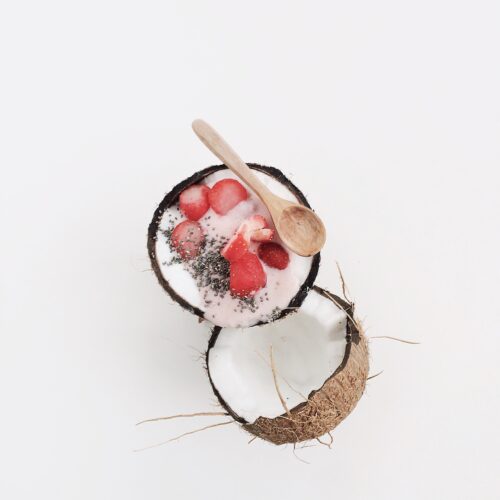Spinach & Cheese Omelet: A Quick and Nutritious Breakfast
A quick and easy egg recipe you can make in five minutes Enjoy this healthy breakfast omelet with a few slices of bacon, buttered toast and a nice cup of coffee.
A quick and easy egg recipe you can make in five minutes Enjoy this healthy breakfast omelet with a few slices of bacon, buttered toast and a nice cup of coffee.
This no-bake date fudge takes about 30 minutes to set up but uses just a few healthy ingredients. This quick and healthy confection is paleo-compatible and chock-full of satisfying fiber and yummy chocolate.
I have struggled with weight throughout my adult life, and being fond of all things chocolate has not helped me on that journey at all! Diabetes is prevalent in my family, and I am determined not to become its next victim. Yet, I still love eating chocolate sweets so I had to look for alternatives that would allow me to have my cake and eat it too. 🙂
Fortunately, I love a challenge so I set about searching for the perfect sweeteners to serve as substitutes in all my baking and cooking applications. The sweeteners I found serve as perfect sugar alternatives for diabetics, low-carbers, and those following the Keto and Paleo diets.
Just as you can have various types of sugar for different recipes, so too are there varieties of sugar-free sweeteners. I’ll go through a list of suitable substitutes for diabetics as well as those interested in using less refined white sugar in their diets. This list will first focus on the completely sugar-free sweeteners and end with one real sugar alternative.
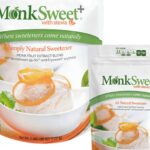
This is by far my favorite sugar substitute! In the multifaceted world of sugar-free sweeteners, this one is the absolute best in my opinion, because using this product is almost the same as using real sugar. It’s twice as sweet as sugar so you’d use half as much of the required amounts in a recipe.
Steviva MonkSweet with Stevia is comprised of erythritol (sugar alcohol), monk fruit extract, and stevia extract. Erythritol is a very common sugar substitute and is present as a bulking agent in almost every artificial sweetener out there. It has a slight cooling effect on the palate and is difficult to dissolve in liquid. Monk fruit and stevia are well-known plants that contain calorie-free sweetening compounds.
Stevivia Brand, the company that produces Monk Sweet+ with Stevia somehow managed to combine these three common sugar alternatives to exquisite perfection.
Pros
You can use Monk Sweet+ with Stevia to sweeten almost anything including:
Cons
In all honesty, I’m hard-pressed to find anything negative to say about this sugar alternative. Although it’s a fine powder, it can be slightly grainy in some applications. I solve this problem by pulverizing it in a Magic Bullet blender. This makes any lingering grittiness disappear and enhances the enjoyment of whatever you’re making.
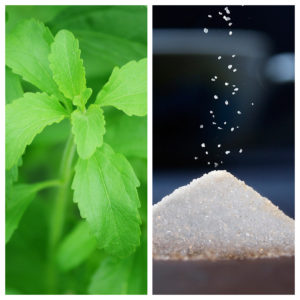
In case you don’t know what stevia is, here’s a blurb from Wikipedia:
“Stevia (/ˈstiːviə, ˈstɛviə/)[1][2] is a sweetener and sugar substitute extracted from the leaves of the plant species Stevia rebaudiana, native to Brazil and Paraguay. The body does not metabolize the glycosides in stevia and therefore it contains 0 calories like some artificial sweeteners. Stevia’s taste has a slower onset and longer duration than that of sugar, and some of its extracts may have a bitter or licorice-like aftertaste at high concentrations.”
Stevia is among the top choices of sugar alternatives for diabetics. It’s available in liquid or powder form. The liquid form may contain alcohol or glycerin for the alcohol-free version. The powder form sometimes contains fillers so read the label to ensure you’re getting only pure stevia extract.
The liquid and powdered forms of stevia are mostly used in beverages, hot or cold, as it works very well to sweeten liquids. With stevia, you have to find the perfect amount for your palate – too little and you won’t taste any sweetness, too much and you get a bitter aftertaste. I like Trader Joe’s and NOW Better Stevia Liquid Extract brands.
Pros
Cons
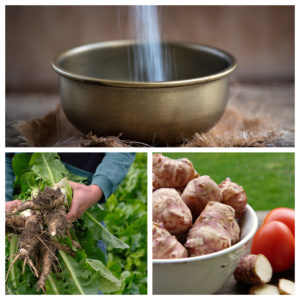
Another great sugar alternative for diabetics, inulin is a prebiotic fiber that is usually derived from plants, most notably chicory and Jerusalem artichokes. It doesn’t raise blood sugar levels, so it’s the perfect sugar alternative for diabetics. Per Wikipedia:
“Inulins are a group of naturally occurring polysaccharides produced by many types of plants,[1] industrially most often extracted from chicory.[2] The inulins belong to a class of dietary fibers known as fructans. Inulin is used by some plants as a means of storing energy and is typically found in roots or rhizomes. Most plants that synthesize and store inulin do not store other forms of carbohydrate such as starch.”
I was very impressed the first time I used inulin. I purchased a brand called Chocoperfection and used it in baking recipes as well as for beverages. It does have a serious drawback that prevents me from ranking it at the top with Monk Sweet+ with Stevia. I’ll get into that a bit more below.
Pros
Cons
If you’re like me and among the few people who are affected by inulin’s side effects, this may not be the sugar substitute choice for you. It’s a bummer because it’s an otherwise excellent sweetener.
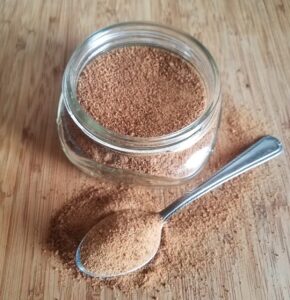
I placed coconut sugar at the end of this list, well because it’s sugar. Sugar is sugar, no matter what type we’re discussing. Coconut sugar is derived from the sap of the coconut flower. Here’s Wikipedia’s description:
“Coconut sugar (also known as coco sugar, coconut palm sugar, coco sap sugar, or coconut blossom sugar) is a palm sugar produced from the sap of the flower bud stem of the coconut palm.[1]
Other types of palm sugar are made from the Palmyra palm, the date palm, the sugar date palm, the sago palm, or the sugar palm. Used as a sweetener in many countries, coconut sugar has no significant nutritional or health benefits over other sweeteners.”
There are a few benefits to using coconut sugar that make it a better alternative for diabetics – it has a very low glycemic index. This means that it will not raise your blood sugar levels as much as it would if you used regular sugar.
Coconut sugar is also delicious. When I want a bit more depth of flavor in my dessert recipes, I may substitute part of the sweetener with coconut sugar.
Pros
Cons
In addition to the sweeteners I’ve mentioned above, I am including some bonus recommendations that fit the criteria of being sufficiently sweet, filler-free, appropriate for diabetics, and for many other diets including keto and paleo.
Other Sugar Alternatives
I hope I have demonstrated that finding sugar alternatives for diabetics is easier than it has ever been. I recommend you try out some of the ones I’ve mentioned in this article to find the one(s) that fit with your lifestyle and way of eating.
Let me know which ones work best for you in the comments. Happy Eating!
Whether you’re trying to lose weight or you’re on a restricted diet, it can become very difficult to come up with tasty meal ideas every day of the week. Trust me I know – you’re on a diet or you want to eat healthy but Read more
Of all the meal courses, dessert is my favorite. Specifically speaking, anything chocolate makes me swoon and my taste buds happy. Of all the meal ideas I have at my disposal, the dessert category has the most recipes hands down! Unfortunately, and as delicious as Read more
Breakfast is often called the most important meal of the day, and with this Coconut & Chia Breakfast Pudding, you’ll not only kickstart your morning with a burst of energy but also enjoy a deliciously creamy and nutritious meal. This easy-to-make pudding combines the richness of coconut milk with the nutrient-dense power of chia seeds, making it a perfect choice for those who want a wholesome breakfast without the hassle of cooking.
One of the main reasons this pudding is such a great breakfast option is its combination of simplicity, nutrition, and taste. With just a few ingredients, you can create a meal that’s high in healthy fats, high in fiber, and completely satisfying. It’s a no-cook recipe, so you can prepare it the night before and wake up to a ready-to-eat breakfast, making it perfect for busy mornings.
Chia seeds are a nutritional powerhouse. These tiny seeds are packed with omega-3 fatty acids, fiber, protein, and antioxidants, making them an excellent addition to any meal. When combined with liquid, chia seeds form a gel-like consistency, which thickens the pudding and gives it a creamy texture. Plus, they help keep you feeling full for longer, thanks to their high fiber content.
On the other hand, coconut milk brings a smooth, tropical flavor and a dose of healthy fats that help sustain energy throughout the day. Whether you’re following a dairy-free, vegan, or paleo diet, coconut milk is a fantastic alternative to traditional dairy. Its creamy texture and subtle sweetness complement the chia seeds perfectly, creating a pudding that’s both light and indulgent.
Chia seeds might be small, but they pack a serious nutritional punch. As one of the best plant-based sources of omega-3 fatty acids, they help support heart health, reduce inflammation, and improve brain function. The high fiber content in chia seeds also supports digestion and promotes satiety, making this pudding a great option for those looking to stay full and energized throughout the morning.
Chia seeds also have the unique ability to absorb up to 10 times their weight in liquid, which is why they’re perfect for creating puddings and other gel-like dishes. When combined with coconut milk, the chia seeds expand and thicken, turning this simple mixture into a creamy, delicious breakfast.
Full-fat coconut milk is an essential ingredient in this pudding, not only because of its flavor but also because it’s a source of medium-chain triglycerides (MCTs). MCTs are a type of fat that is quickly absorbed and used for energy, making them a great addition to a breakfast meal. Coconut milk also contains lauric acid, which has antimicrobial properties and helps support a healthy immune system.
For those following a plant-based or lactose-intolerant diet, coconut milk is an excellent dairy-free alternative that still provides creaminess and richness. Its naturally sweet and tropical flavor pairs perfectly with the other ingredients in the pudding, making it both satisfying and refreshing.
This Coconut & Chia Breakfast Pudding is naturally sweetened with liquid stevia, a zero-calorie sweetener derived from the stevia plant. Stevia is a popular alternative to sugar because it doesn’t raise blood sugar levels and can be used in small amounts to achieve the desired sweetness. This makes the pudding suitable for those following low-sugar or keto diets while still delivering a hint of sweetness.
If you prefer, you can also customize the sweetness to your liking by adjusting the amount of stevia, or using other natural sweeteners like maple syrup, honey, or monk fruit extract.
A splash of coconut water in the pudding adds extra hydration and a subtle flavor twist. Coconut water is known for its high levels of electrolytes, especially potassium, which helps regulate fluid balance and prevent dehydration. This addition makes the pudding not only creamy but also hydrating, which is particularly beneficial in the morning when you’re rehydrating after a night’s sleep.
When it’s time to enjoy your breakfast pudding, the final step is adding your berries of choice. Whether you opt for strawberries, blueberries, raspberries, or even a mix, berries not only add color and freshness but also deliver a variety of health benefits. They’re rich in antioxidants, fiber, and vitamin C, which support immune function and overall health.
Berries also bring a natural sweetness and tartness that complement the rich coconut flavor and smooth chia texture, making every bite more exciting. Plus, they’re low in calories and high in nutrients, which makes them a great topping for this pudding, or any meal.
One of the best things about this recipe is its versatility. While the coconut milk and chia seed combination is delicious on its own, you can also get creative with the recipe by adding your own personal touch:
With its make-ahead convenience, this Coconut & Chia Breakfast Pudding is perfect for those mornings when you’re in a rush but still want a nutritious meal. Simply mix the ingredients the night before, let the chia seeds work their magic overnight, and wake up to a delicious breakfast waiting for you in the fridge.
It’s also great for meal prep. You can make several servings at once and store them in individual containers, ensuring you have a healthy, grab-and-go breakfast option for the whole week.
Whether you’re following a vegan, paleo, or low-carb lifestyle, this pudding fits the bill, offering a satisfying, nutrient-dense meal that keeps you energized and focused throughout your morning.
This Coconut & Chia Breakfast Pudding is a simple, yet nourishing breakfast that’s packed with flavor and nutrition. It’s quick to prepare, easy to customize, and the perfect way to start your day on a healthy note.
